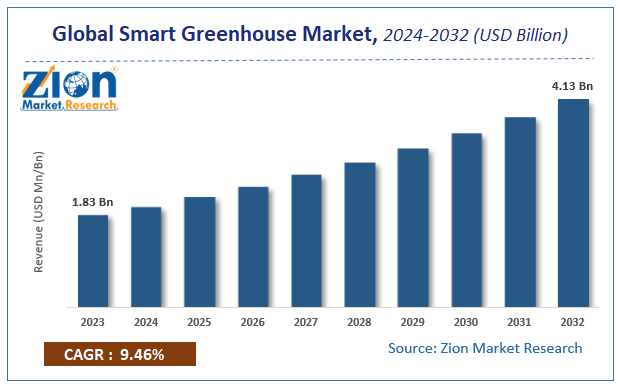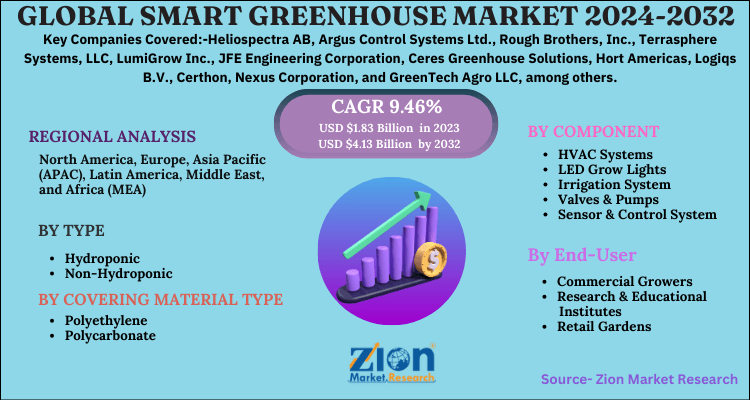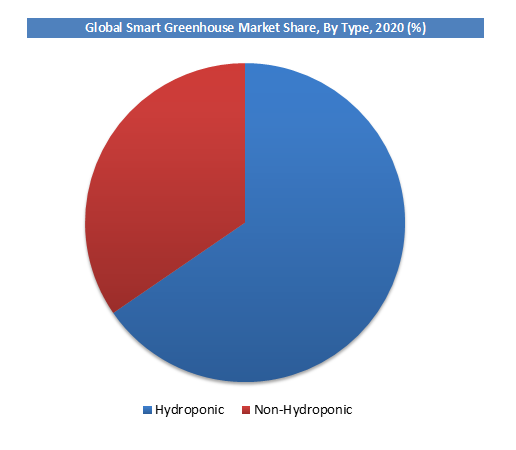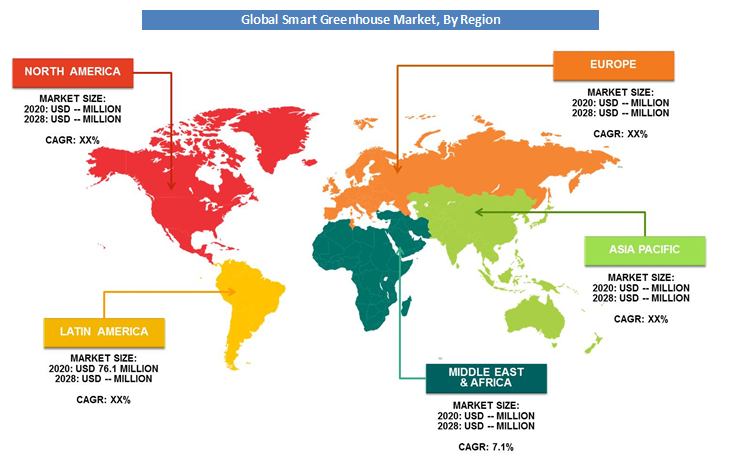Smart Greenhouse Market Size, Share, Analysis, Trends, Growth, 2032

Smart Greenhouse Market By Type (Hydroponic and Non-Hydroponic), By Covering Material Type (Polyethylene, Polycarbonate, and Others), By Component (HVAC Systems, LED Grow Lights, Irrigation System, Valves & Pumps, Sensor & Control System, and Others), By End User (Commercial Growers, Research & Educational Institutes, Retail Gardens, and Others): Global Industry Perspective, Comprehensive Analysis and Forecast, 2024 - 2032-
| Market Size in 2023 | Market Forecast in 2032 | CAGR (in %) | Base Year |
|---|---|---|---|
| USD 1.83 Billion | USD 4.13 Billion | 9.46% | 2023 |
Smart Greenhouse Market Insights
According to Zion Market Research, the global Smart Greenhouse Market was worth USD 1.83 Billion in 2023. The market is forecast to reach USD 4.13 Billion by 2032, growing at a compound annual growth rate (CAGR) of 9.46% during the forecast period 2024-2032. The report offers a comprehensive analysis of the market, highlighting the factors that will determine growth, potential challenges, and opportunities that could emerge in the Smart Greenhouse Market industry over the next decade.
Smart Greenhouse Market: Overview
The smart greenhouse is creating a self-regulating, micro-climate appropriate for plant growth through the use of actuators, sensors, and monitoring and control systems that automate the growing process and optimize growth conditions. The main objective of the smart greenhouses is to enhance farming outcomes and improve the productivity of the farmers.
Smart Greenhouse Market: COVID-19 Impact Analysis
The COVID-19 pandemic has impacted many end-use sectors, as most companies’ operations are temporarily on hold across major processing and manufacturing units. Prior to this pandemic, industries were competitive, which led to adopting different technologies to a larger extent. The agriculture technology sector was also prospering with the adoption of new and improvised techniques, such as big data analytics and IoT. However, with this pandemic, several sectors have kept their products and projects on hold, which has adversely impacted businesses associated with technology. Furthermore, the financial impact on farmers has resulted in a reduction in non-essential investments and spending.
Smart Greenhouse Market: Growth Factors
Since the global population is rising at a substantial rate, food production worldwide needs to be doubled. Therefore, farmers are probable to witness immense pressure for rising in their crop production either by adopting developing techniques such as vertical farming smart greenhouses or by making the land arable to grow crops. The scarcity of cultivable land in urban areas led farmers to adopt new and improvised solutions.
Furthermore, the emerging trend of industrial improvements and rooftop cultivation is foreseen to strengthen the development of the market in the future. The increase in vertical cultivation in urban areas and the emerging awareness among buyers with respect to the benefits of improving smart greenhouses are estimated to drive the market's development.
Smart Greenhouse Market: Report Scope
| Report Attributes | Report Details |
|---|---|
| Report Name | Smart Greenhouse Market |
| Market Size in 2023 | USD 1.83 Billion |
| Market Forecast in 2032 | USD 4.13 Billion |
| Growth Rate | CAGR of 9.46% |
| Number of Pages | 130 |
| Key Companies Covered | Heliospectra AB, Argus Control Systems Ltd., Rough Brothers, Inc., Terrasphere Systems, LLC, LumiGrow Inc., JFE Engineering Corporation, Ceres Greenhouse Solutions, Hort Americas, Logiqs B.V., Certhon, Nexus Corporation, and GreenTech Agro LLC, among others |
| Segments Covered | By Type, By Covering Material Type, By Component, By End-User and By Region |
| Regions Covered | North America, Europe, Asia Pacific (APAC), Latin America, Middle East, and Africa (MEA) |
| Base Year | 2023 |
| Historical Year | 2018 to 2022 |
| Forecast Year | 2024 - 2032 |
| Customization Scope | Avail customized purchase options to meet your exact research needs. Request For Customization |
Type Size Segment Analysis Preview
Hydroponics held a share of over 60% in 2020. Hydroponics is a method in which rather than growing in soil plants are grown in a nutrient solution. This technique uses specially planned benches with troughs to enable the suspension of plants in water. Smart greenhouses based on hydroponics use pebbles, sand, or sawdust since they contain a substantial water-holding capacity. The roots grew within secure plants in containers. Hydroponics-based greenhouses enable agricultural practices without soil to decrease the consumption of natural resources, thereby popularizing this farming technique to be adopted by a significant number of stakeholders, ranging from professional growers, supermarkets, and home gardeners to restaurants.
End-User Segment Analysis Preview
Research & educational institutes segment is projected to grow at a CAGR of around 11% from 2024 to 2032. Market Players are catering smart greenhouses to these institutes for private-public research. They are catering to fully functional greenhouse facilities by accommodating different plant research equipment and plant systems in their plans for the optimum performance of the research facilities. Research greenhouses can be large or small, depending on the need for research activities to be carried out. The main end users of smart greenhouses are Research & educational institutes as they carry out research activities related to different fruits, flowers, and vegetables, as well as it provides hands-on experience to the concerned in schools and campuses.
Smart Greenhouse Market: Regional Analysis Preview
Europe accounted for a share of over 25% in 2023. The strong development of this region can be attributed to the expanding allocation of smart greenhouse technology innovation over the recent period of time. Furthermore, an important commitment from Spain, Netherlands, and Italy is anticipated to back up the development of the smart greenhouse sector in Europe.
Asia Pacific is projected to grow at a CAGR of over 12% during the forecast period. The speedy pace of urbanization in the region is one of the crucial elements estimated to stimulate the evolution of the smart greenhouse market in the coming years.
Smart Greenhouse Market: Competitive Landscape
Some of the key players in the smart greenhouse market are
- Heliospectra AB
- Argus Control Systems Ltd.
- Rough Brothers Inc.
- Terrasphere Systems LLC
- LumiGrow Inc.
- JFE Engineering Corporation
- Ceres Greenhouse Solutions
- Hort Americas
- Logiqs B.V.
- Certhon
- Nexus Corporation
- GreenTech Agro LLC
- among others.
Key players are focusing on strategies such as new product development, investment in R&D, and innovation to grow their market share.
The global smart greenhouse market is segmented as follows:
By Type
- Hydroponic
- Non-Hydroponic
By Covering Material Type
- Polyethylene
- Polycarbonate
- Others
By Component
- HVAC Systems
- LED Grow Lights
- Irrigation System
- Valves & Pumps
- Sensor & Control System
- Others
By End-User
- Commercial Growers
- Research & Educational Institutes
- Retail Gardens
- Others
By Region
- North America
- The U.S.
- Canada
- Europe
- France
- The UK
- Spain
- Germany
- Italy
- Rest of Europe
- Asia Pacific
- China
- Japan
- India
- South Korea
- Southeast Asia
- Rest of Asia Pacific
- Latin America
- Brazil
- Mexico
- Rest of Latin America
- Middle East & Africa
- GCC
- South Africa
- Rest of The Middle East & Africa
Table Of Content
Methodology
FrequentlyAsked Questions
The global smart greenhouse market was valued at USD 1.83 Billion in 2023.
The global smart greenhouse market is expected to reach USD 4.13 Billion by 2032, growing at a CAGR of 9.46% between 2024 to 2032.
Some of the key factor driving the global smart greenhouse market growth is increasing population.
Europe region held a substantial share of the smart greenhouse market in 2023. Asia Pacific region is projected to grow at a significant rate.
Some of key players in smart greenhouse market are Heliospectra AB, Argus Control Systems Ltd., Rough Brothers, Inc., Terrasphere Systems, LLC, LumiGrow Inc., JFE Engineering Corporation, Ceres Greenhouse Solutions, Hort Americas, Logiqs B.V., Certhon, Nexus Corporation, and GreenTech Agro LLC, among others.
RelatedNews
HappyClients
Zion Market Research
Tel: +1 (302) 444-0166
USA/Canada Toll Free No.+1 (855) 465-4651
3rd Floor,
Mrunal Paradise, Opp Maharaja Hotel,
Pimple Gurav, Pune 411061,
Maharashtra, India
Phone No +91 7768 006 007, +91 7768 006 008
US OFFICE NO +1 (302) 444-0166
US/CAN TOLL FREE +1 (855) 465-4651
Email: sales@zionmarketresearch.com
We have secured system to process your transaction.
Our support available to help you 24 hours a day, five days a week.
Monday - Friday: 9AM - 6PM
Saturday - Sunday: Closed








